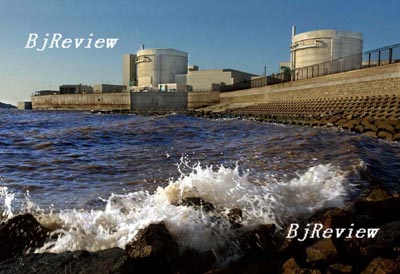|

About 110 km north of Dalian, Liaoning Province, lies a village called Wentuozi. The several hundred households of this village east of the Bohai Sea have lived a tranquil life for many years, relying on agriculture and fishing for their livelihood. In 2005, the thunder of machines broke that tranquility after it was chosen as a site for a nuclear power plant. On August 18, 2007, the principal construction of the Hongyanhe Nuclear Power Plant was officially started near Wentuozi.
Information from the National Development and Reform Commission indicates that Hongyanhe Nuclear Power Plant will be the only plant in China starting four gigawatt (gw)-level generating units at once, after business operation begins in 2012.
More to come
At present, China has 11 nuclear power generating units in operation with a total installed capacity of 8.7 gw. Among the country's total installed electrical capacity, nuclear power accounts for only 1.8 percent and contributed only 2.3 percent of the total power production. However, this situation is changing gradually. Since 2005, China has started construction of nuclear power plants each year. As a technologically mature, safe, economical and clean energy available for large-scale production, nuclear power is of great potential in China's long-term development.
In 2005, China launched the Medium- and Long-Term Plan of Nuclear Power Development, speeding up mass construction of nuclear power plants and advancing the industrialization process.
"According to the plan, there will be installed capacity of 40 gw by 2020, accounting for 4 percent of the country's total installed capacity and 6 percent of the total power production," said Xia Guojun, former Secretary General of the Society for Nuclear Power Generation of the Chinese Society for Electrical Engineering. "Considering that there is a five-year construction period for nuclear power plants, in the following decade China must start construction of at least three gw-level nuclear power generating units every year."
At present, the two companies with licenses for providing nuclear power, namely, China National Nuclear Corp. (CNNC) and China Guangdong Nuclear Power Group (CGNPC), have strengthened investment in their expansion. Moreover, four state-owned power generators, namely, China Huaneng Group, China Datang Corp., China Huadian Corp. and China Guodian Corp., are preparing to construct their own nuclear power plants. CNNC and CGNPC have introduced the third-generation technologies via international open tender and have invested in construction of nuclear power plants in Sanmen, Zhejiang Province, and Yangjiang, Guangdong Province, both of which are under construction. Among them, Guangdong Yangjiang Nuclear Power Plant will be the largest nuclear power plant in China, with an installed capacity of six gw-level generating units.
Besides Zhejiang and Guangdong, more than 10 provinces and municipalities have proposed plans for nuclear power development.
In order to satisfy the demand for nuclear power development, China is strengthening efforts to prospect for uranium resources, looking for large and super reserves of natural uranium resources. Geological surveys have been conducted over uranium resources in Ili Basin and Ordos Basin in north China and Xiangshan ore field in Jiangxi Province.
Development of nuclear power also brings huge business opportunities for nuclear power equipment manufacturing and other related industries. By 2020, total investment in nuclear power construction will reach 300 billion yuan, 150 billion yuan of which will be put into equipment manufacturing. If 60-70 percent of the equipment can be made by China, Chinese nuclear power equipment manufacturers will enjoy profits of over 100 billion yuan. As the field of nuclear power equipment investment is opened to non-state capital, much private and foreign capital has started to flow into China's nuclear power construction.
Homegrown technologies
The Hongyanhe Nuclear Power Plant will adopt nuclear reactor technologies independently developed by China. This is second-generation nuclear power technology, more mature and safer than similar second-generation nuclear power technologies around the world. Of the four gw-level generating units of Hongyanhe Nuclear Power Plant, 70 percent of equipment of the No.1 and No.2 generating units and 80 percent of that of No.3 and No.4 generating units are made by China, while 85 percent of all the key equipment is locally made.
Besides the second generation of improved nuclear power technology, the third generation of application technology is now in use. However, the third generation technology is introduced from the United States. "Our goal now is to take our nuclear power technology from the third generation to the fourth generation as soon as possible," said Xia. "Focusing on independent innovation of nuclear power technologies and equipment manufacturing is one of the targets for China to peacefully utilize nuclear energy."
From the beginning of development of nuclear power, China has mainly relied on its own innovation. During the past few decades, China has made important achievements in nuclear power technologies, cycling technologies of nuclear fuels and basic nuclear research and so on, which have kept pace with or lead international nuclear technology field.
In terms of nuclear power plant construction, China has gained rich experience in engineering designing, construction and project management. It has the capability of independently designing 300-megawatt (mw) and 600-mw pressurized-water reactor (PWR) nuclear power plants. Particularly, the fuel elements can be manufactured by China and the performance has reached the international level. Comparatively complete security systems of nuclear safety, environmental protection and nuclear emergency measures have been developed.
CNNC is now the most important investor and the largest owner of all the nuclear power plants in operation on the Chinese mainland. It is an important force for the independent designing and developing of nuclear power, the only supplier of nuclear fuel, an important technology service provider for nuclear power operation and a professional supplier of nuclear instruments and apparatus, assuming important tasks in safeguarding nuclear power plant operation and safety technologies.
| 